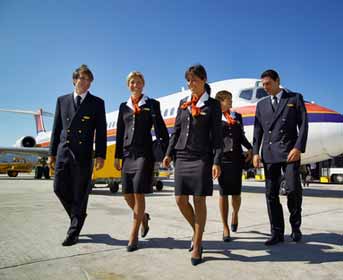Airline Flight Attendant Jobs
Flight attendants are the face of the airlines; they constitute most of the contact between airlines and their customers, and often are the basis for comparison between airlines. The quality of their service is so crucial to the success of an airline’s bottom line that newly hired flight attendants must go through rigorous public relations training before they even think about serving their first cup of coffee onboard.
Flight attendants represent one of the largest job categories in the airline industry. Airlines in the United States currently employ approximately 100,000 flight attendants, and hire thousands more each year. These jobs are some of the most coveted positions in the travel business. One of the best ways to break into the airline industry is to become a flight attendant. In the next few years, the number of passengers flying is expected to increase as the economy bounces back.
Flight Attendant Job Responsibilities
The primary responsibility of a flight attendant is the safety of the passengers and the aircraft cabin. After that, they offer personalized service to the passengers to ensure their safety and comfort while on the plane. This means operating equipment needed for the heating of drinks or meals. Paying attention passenger needs can be difficult at times because passengers are sometimes hard to please and the time to wait on each is very limited. In an emergency, they help evacuate the plane, give first aid, and are trained to know what to do in the event of disruptive passengers, bomb threats, and hijackings.
Did You Know? Flight attendants often enjoy greatly discounted prices for travel, cruises, theme parks, car rentals, and much more.
People working as flight attendants may also provide some assistance to station agents, or help passengers find their connecting flights. At times, flight attendants may make some public relations appearances at high schools, or events such as fundraising campaigns, sales meetings, conventions, and more. Read the next page for more details.
Job Requirements
Flight attendants work odd hours, but can expect to work up to 12 hours a day, but 14 are possible. A typical work schedule is between 35 to 50 hours each month flying time, and an additional 35 hours or more non-flying time. Altogether, they will get about 156 days off a year, but they may not occur while at their home city (called a “domicile”).
When applying for these positions, you will need to be physically fit – and look like you are, too. You will often be bending, stooping, lifting up to 45 pounds, standing and walking for extended periods. You will also need to be present one hour before any flight for a crew briefing. It is probable that you will need to buy your first uniform, which will cost between $600 and $800, but are usually taken out of your pay in installments. These are custom-fitted, and the airline will probably pay for additional uniforms.
Training & Degrees
In order to be considered a candidate, you will need to have a minimum of an H.S. Diploma or GED, but some college will be better. Some experience in customer service is even better. You will need to be at least 21 (some will take 18-year-olds), and there is no maximum age. Speaking a second language is preferable if the airline travels to foreign airports, and you may need a passport. You probably want to avoid private flight attendant schools, since they can be costly and they cannot guarantee you a job.
Flight attendant candidates attend a training school which may extend between four to seven weeks. During that time, they will go on training flights with real passengers. Each year, flight attendants receive about 14 hours of instruction to provide up-to-date emergency procedures, and more information on dealing with passengers. After graduation, in which a 90 percent grade is required, new flight attendants will be sent to a domicile location – which will depend on the needs of the airline. New attendants will usually only fly when a senior attendant is on vacation or sick, and will need to build up hours before flying regularly. You will need to pass an FBI background investigation that may go back ten years.
Salary & Benefits
The annual salary varies widely between airlines. An average starting salary is about $38,000 (some only make $18,000), but later on you can earn more than $80,000 with some airlines. Besides an hourly pay, you will also receive a per diem (per day) pay for every hour that you are required to be away from your domicile. This pay covers your costs such as meals. Airlines generally cover the cost of hotels and transportation to and from it. Other benefits will most likely include medical, dental, and vision coverage, life insurance, a Flexible Spending Account, a 401k program, a stock purchase program, a college fund, short and long-term disability coverage, discounted flights, and more.
Quick Summary of Flight Attendant Employment:
- Many more flight attendants will soon be needed due to larger planes and more passengers traveling.
- Flight attendants are trained by the particular airline.
- Other than being older than about 21, there is no age maximum to become a flight attendant.
- Flight attendants enjoy travel and other great benefits.


 Teach English in Asia
Teach English in Asia  Cruise Ship Jobs
Cruise Ship Jobs  Alaska Fishing Industry Jobs
Alaska Fishing Industry Jobs  Sharing Economy / Gig Economy
Sharing Economy / Gig Economy 